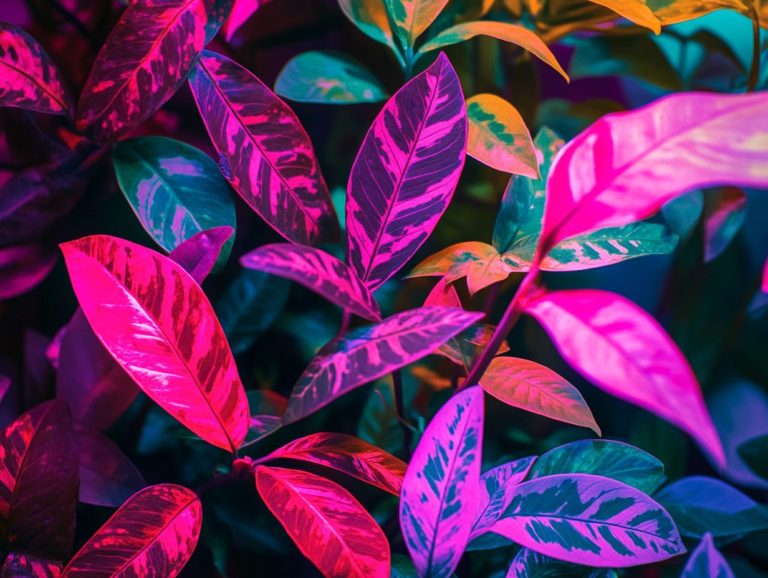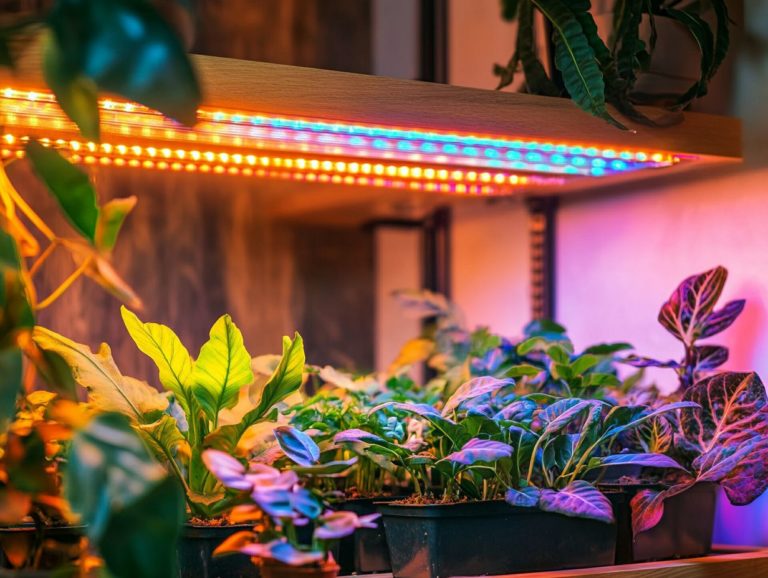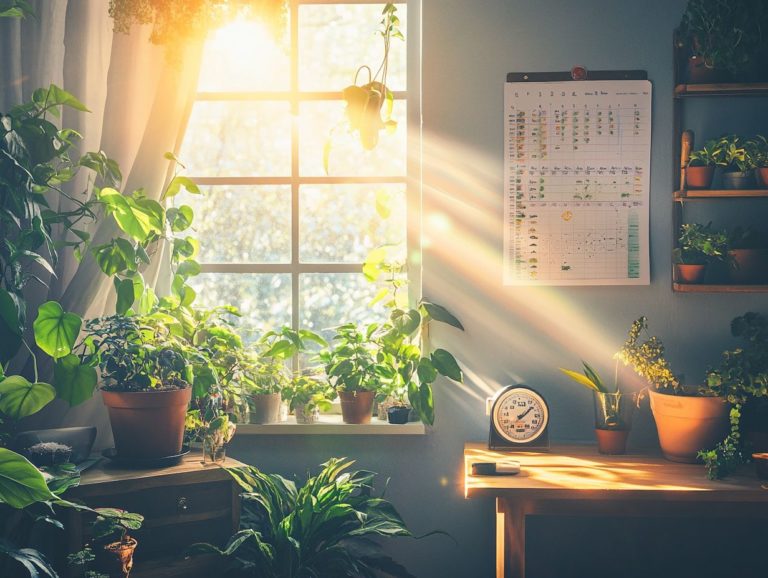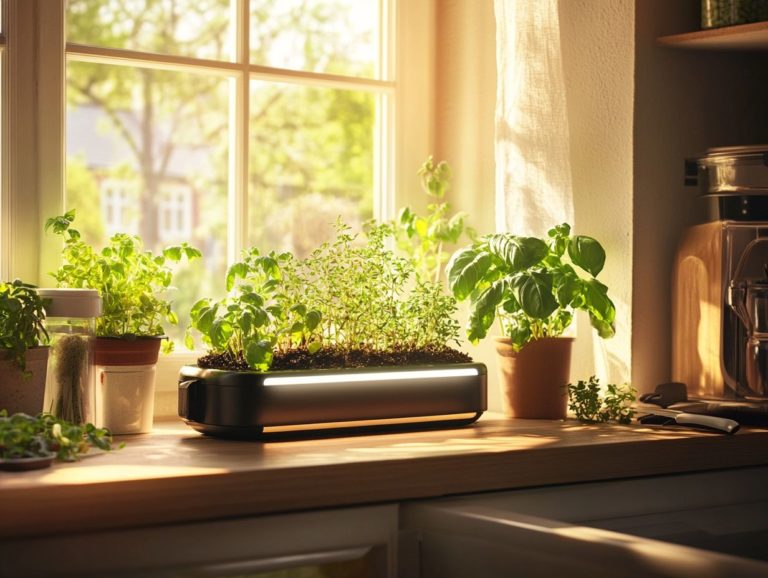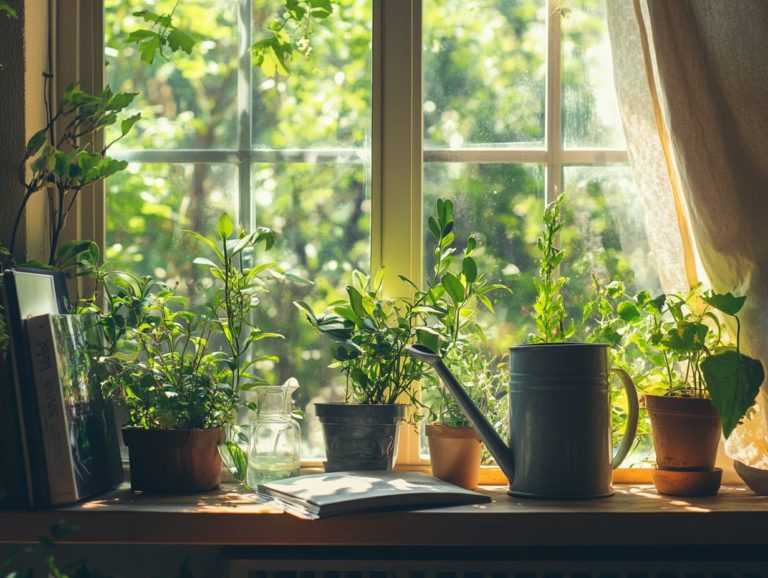How to Create a Plant Light Management Plan
Understanding the light requirements of your plants is essential for their growth and overall vitality.
This article delves into the myriad factors that affect light requirements, the advantages of a customized plant lighting plan, and how to develop one that aligns perfectly with your space and plant species.
From selecting the ideal lighting system to addressing common challenges, you’ll acquire practical insights and strategies to enhance your plants’ environment.
Immerse yourself to ensure that your green companions flourish!
Contents
- Key Takeaways:
- Understanding Plant Light Requirements
- Factors Affecting Light Requirements
- Benefits of a Plant Lighting Plan
- Creating a Plant Light Management Plan
- Troubleshooting Common Issues
- Tips and Considerations
- Frequently Asked Questions
- What is a plant light management plan?
- Why is it important to create a plant light management plan?
- What factors should be considered when creating a plant light management plan?
- Can I use natural light for my plant light management plan?
- How do I determine the right amount of light for my plants?
- What are some tips for monitoring and adjusting my plant light management plan?
Key Takeaways:
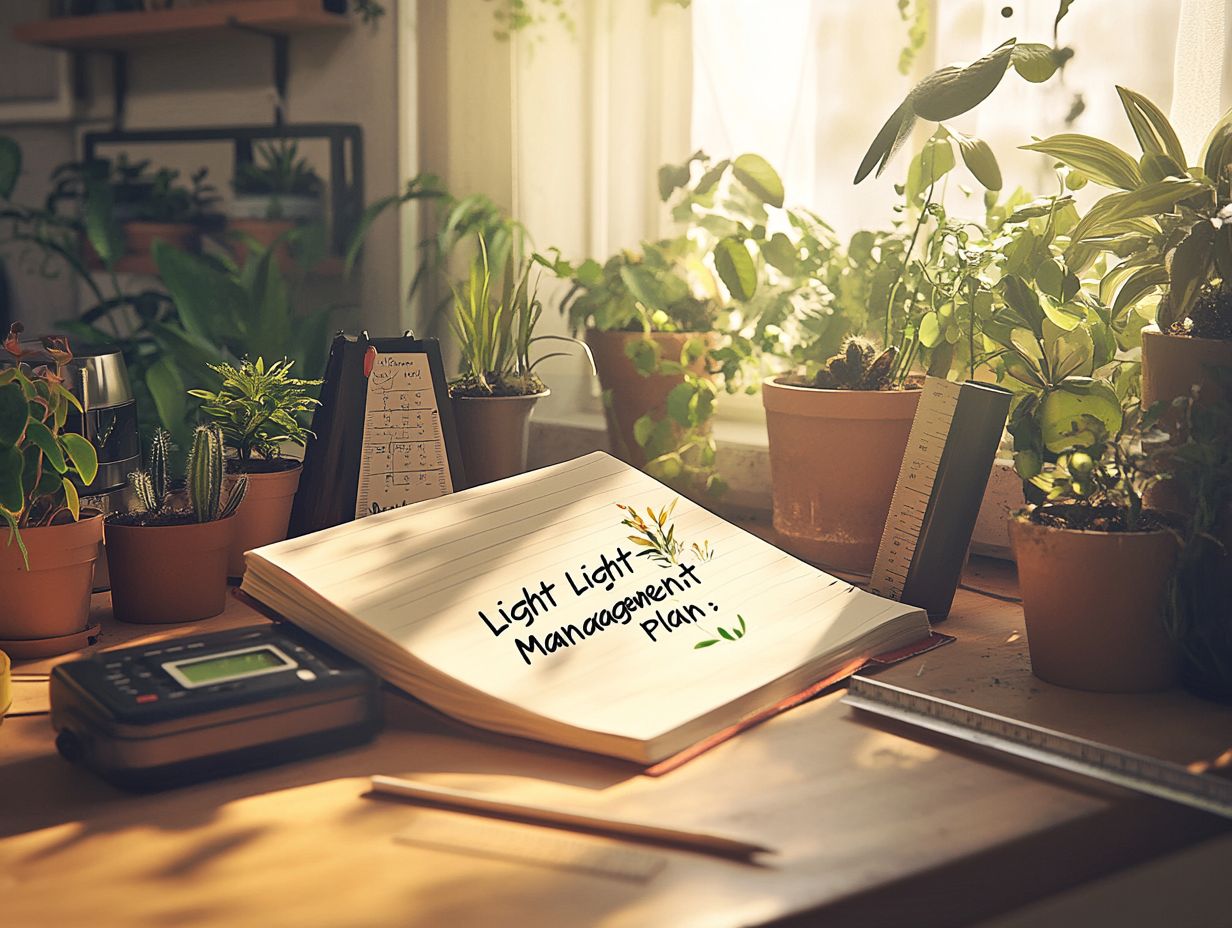
- Understanding your plants’ light requirements is crucial for their growth and health.
- A good plant lighting plan optimizes plant growth and health.
- Creating a plant lighting plan involves assessing your space, choosing the right lighting system, and maintaining a consistent lighting schedule.
Understanding Plant Light Requirements
Understanding the light requirements of your various plants is crucial for thriving indoor gardening. Each plant type has its own unique light needs some crave high light, others thrive in medium light, and some are content with low light conditions.
It’s not just about how much light they receive; the quality, duration, and intensity also matter significantly. These factors directly influence how plants turn light into energy and chlorophyll production. By fine-tuning the light environment, you’ll ensure your plants thrive beautifully while skillfully harnessing both natural sunlight and artificial lighting methods.
Factors Affecting Light Requirements
Several factors are integral to determining the light requirements of your plants, including light intensity and duration. These elements can vary significantly depending on the type of plant and its growing conditions.
For example, if you’re nurturing shade-tolerant species like ferns or certain orchids, you’ll find that they thrive in low-light environments. They adapt beautifully, often maximizing their chlorophyll content to efficiently capture the limited light available. Conversely, if you re working with sun-loving plants such as sunflowers or tomatoes, they demand intense light and may even adjust their leaf orientation to soak up every available ray.
The light spectrum plays a crucial role in plant growth, with red and blue wavelengths being particularly beneficial. If you’re engaging in indoor gardening, using supplemental lighting like LED grow lights can significantly enhance your success by delivering essential light frequencies that your home environment might lack.
For those inclined toward DIY solutions, consider using fluorescent tubes or energy-efficient bulbs to create a tailored setup that ensures your plants receive the light they need to thrive indoors.
Benefits of a Plant Lighting Plan
Implementing a strategic plant lighting plan brings a wealth of advantages to your indoor gardening experience. You’ll witness enhanced plant health and growth, optimized energy efficiency, and improved flowering across various plant species, resulting in vibrant and flourishing gardens.
By honing in on the specific light requirements of your plants, you’ll ensure they receive the right amount of light, maximizing the process they use to turn light into energy and chlorophyll production. This approach eliminates concerns related to inadequate lighting and the excess heat generated by artificial light sources, ensuring your plants thrive beautifully. For more insights, check out these tips for effective plant lighting.
Optimizing Plant Growth and Health
Optimizing plant growth and health hinges on effective ways to manage light for plants that enhance chlorophyll production and ensure efficient photosynthesis, fostering robust and vibrant plants.
By adjusting the distance of your grow lights from the plants, you can prevent leaf scorching or inadequate light exposure. This effectively tailors the intensity to meet specific growth stages.
Incorporating reflective materials in your growing area can further amplify light efficiency, directing more lumens to the plants while minimizing waste.
Choosing the right types of grow lights whether LED, fluorescent, or high-pressure sodium each with its unique advantages, will support diverse growth needs. Implementing these practices not only cultivates a healthier environment but also optimizes growth rates, ultimately leading to thriving plants that are more resilient and productive.
Creating a Plant Light Management Plan
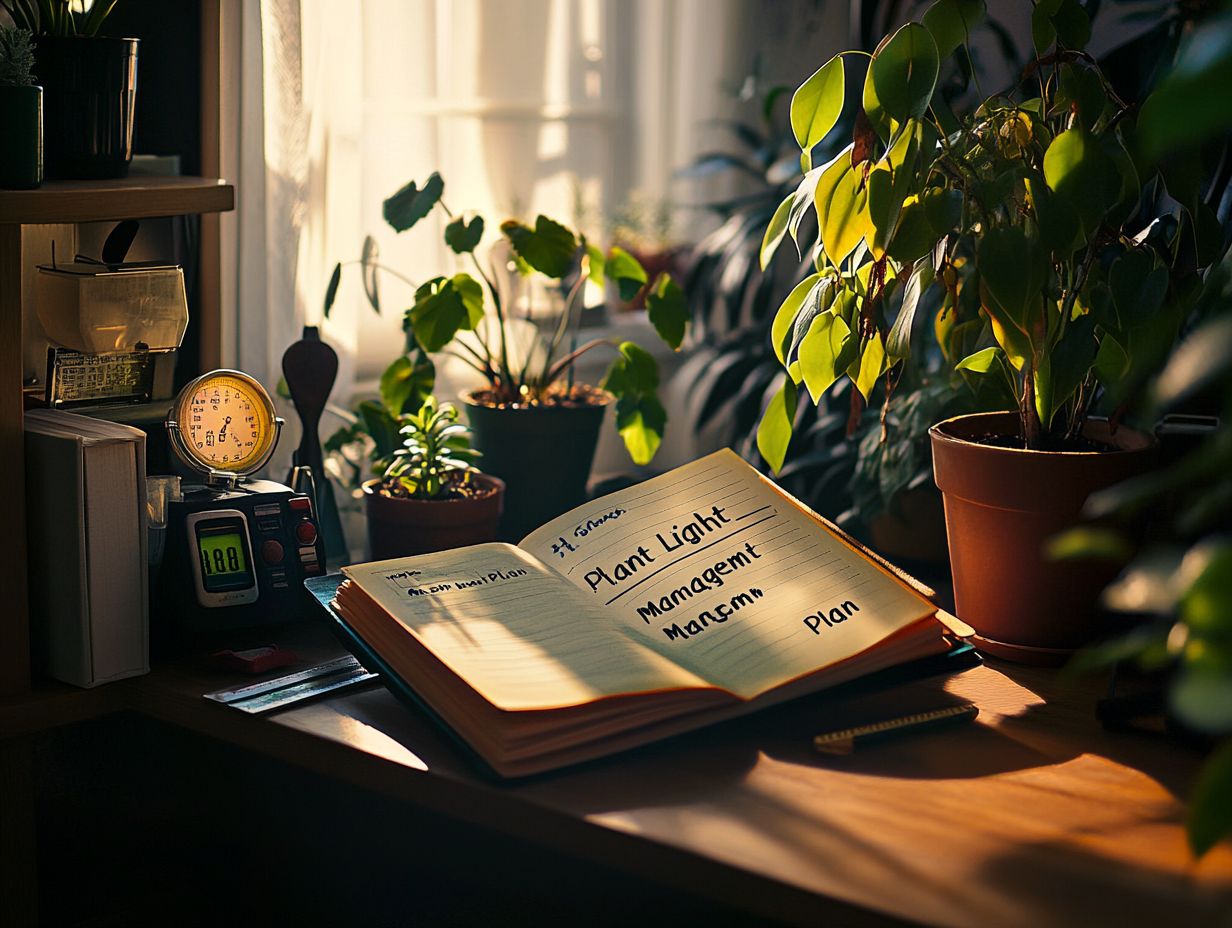
Crafting a comprehensive plant light management plan requires careful consideration of several key elements. You need to think about plant selection, suitable light sources, and effective light coverage to create optimal growing conditions for your plants.
Your plan should also include how to measure light intensity and adjust the distance of the light source. This attention to detail will cater to the specific needs of each plant species, whether they’re thriving indoors or in a carefully controlled environment. For more insights, check out how to manage light for tropical plants.
Assessing Your Space and Plant Species
Assessing your space and plant species is a crucial step in crafting an effective light management plan. After all, different plants have their own unique light preferences and thrive under varying conditions.
Understanding the natural light available in your environment its intensity and duration will greatly influence your choices.
Recognizing the specific light needs of your plants can make a significant difference in their growth. Some may flourish in bright, indirect light, while others prefer the cozy embrace of low-light settings.
To optimize their development, take a close look at the room’s characteristics, such as window placement and any obstacles that might cast shadows. Adjust your artificial lighting setups accordingly.
Consider implementing a rotating schedule for your lights. This approach ensures that each plant type receives the exposure it needs for healthy growth, taking into account lighting considerations for plant growth to create a thriving indoor garden that reflects your dedication and care.
Choosing the Right Lighting System
Choosing the right lighting system is crucial for achieving optimal plant growth and health. Different light sources, like LED lighting and fluorescent bulbs, offer unique benefits in energy efficiency and light quality.
Understanding these distinctions gives you the power to customize your setup to meet your plants’ specific needs. For example, LEDs are celebrated for their low energy consumption and customizable light spectrums. This makes them particularly beneficial for sensitive seedlings or fruiting plants that thrive on certain wavelengths for photosynthesis.
On the other hand, fluorescent bulbs are generally more budget-friendly and produce less heat, which can be advantageous for heat-sensitive species, although they don t provide a broad light spectrum.
When selecting the type of grow lights, it s essential to consider factors such as the type of plants, their growth stage, and your budget. This way, you can ensure that your chosen system effectively supports healthy development.
Ready to see your plants thrive? Start crafting your light management plan today!
Setting Up and Maintaining the Lighting Schedule
Establish a consistent lighting schedule for your plants. This is crucial as it dictates how much light they need to grow.
Provide the right amount of light daily to boost photosynthesis. This process helps with growth, flowering, and fruiting.
Each plant species has its own ideal light duration. Some thrive with longer days, while others prefer shorter ones.
Regularly check on your plants to fine-tune this schedule. Signs of stretching or yellowing may indicate the need for adjustments in light intensity or duration.
Using timers and light sensors simplifies maintaining the right cycle. This encourages vibrant growth and creates a stable environment for your plants.
Troubleshooting Common Issues
Address light deficiencies and excess light to keep your plants healthy. Improper light can lead to leggy plants and stunted growth.
Resolving these challenges helps your plants thrive beautifully.
Identifying and Addressing Light Deficiencies

Identifying light deficiencies is vital for healthy plants. Inadequate light can cause leggy growth and yellowing leaves.
Plants lacking enough light struggle to photosynthesize effectively. To fix this, consider adding LED grow lights to mimic natural sunlight.
Adjusting plant positions can also help them get more light. Regularly monitor conditions with a light meter to see if changes are needed.
Experiment with different light durations to find what works best. This ensures your plants get enough light to thrive without stress.
Dealing with Excess Light and Heat
Managing excess light and heat is crucial for plant health. High light intensity and heat can stunt growth and cause stress.
Start by adjusting the distance between your light source and plants. This helps maintain brightness without scorching them.
Implement temperature controls, like fans, to create a comfortable environment. Choose LED grow lights since they emit less heat.
Regularly observe how your plants respond to light and temperature changes. Catch signs of distress early to prevent long-term damage.
Tips and Considerations
Incorporate these tips for better plant light management. Optimizing light usage from natural sources helps your greenery thrive.
Using Natural Light Sources
Utilizing natural light sources effectively can significantly enhance your plant growth. Strategically positioning your plants can maximize their exposure to sunlight while ensuring the best use of light.
To achieve this, start by assessing the natural light availability in each room. Observe the sun’s path throughout the day, noting areas that bask in direct sunlight versus those that remain shaded.
Typically, south-facing windows provide the most light, making them ideal for light-hungry species in your collection. If sunlight is abundant yet intense in certain rooms, consider placing your plants a bit further from the window to prevent scorching.
Sheer curtains can be invaluable in this process. They diffuse brilliant rays, creating a softer light that reduces excessive heat while still nourishing your greenery. This technique protects your sensitive plants and adds a touch of elegance to your space.
Incorporating Light into Overall Plant Care
Let s dive into how managing light can supercharge your plant care! Incorporating light management into your overall plant care routine is essential for fostering robust growth. This critical component serves as the foundation for other factors, such as watering schedules and nutrient applications.
By striking the right balance, you ensure your plants receive the optimal amount of light. This enables them to make the most of the water and fertilizers you provide. For more information on how to keep track of plant light needs, adjusting light exposure in line with your watering cycles helps avoid overwatering, a common issue when plants aren’t using moisture effectively.
Understanding how various light conditions interact with the way plants absorb nutrients gives you the power to tailor your feeding regimens. This ensures your plants thrive holistically. A thoughtful approach to light management fosters overall health and vitality across a diverse array of plant species.
Frequently Asked Questions
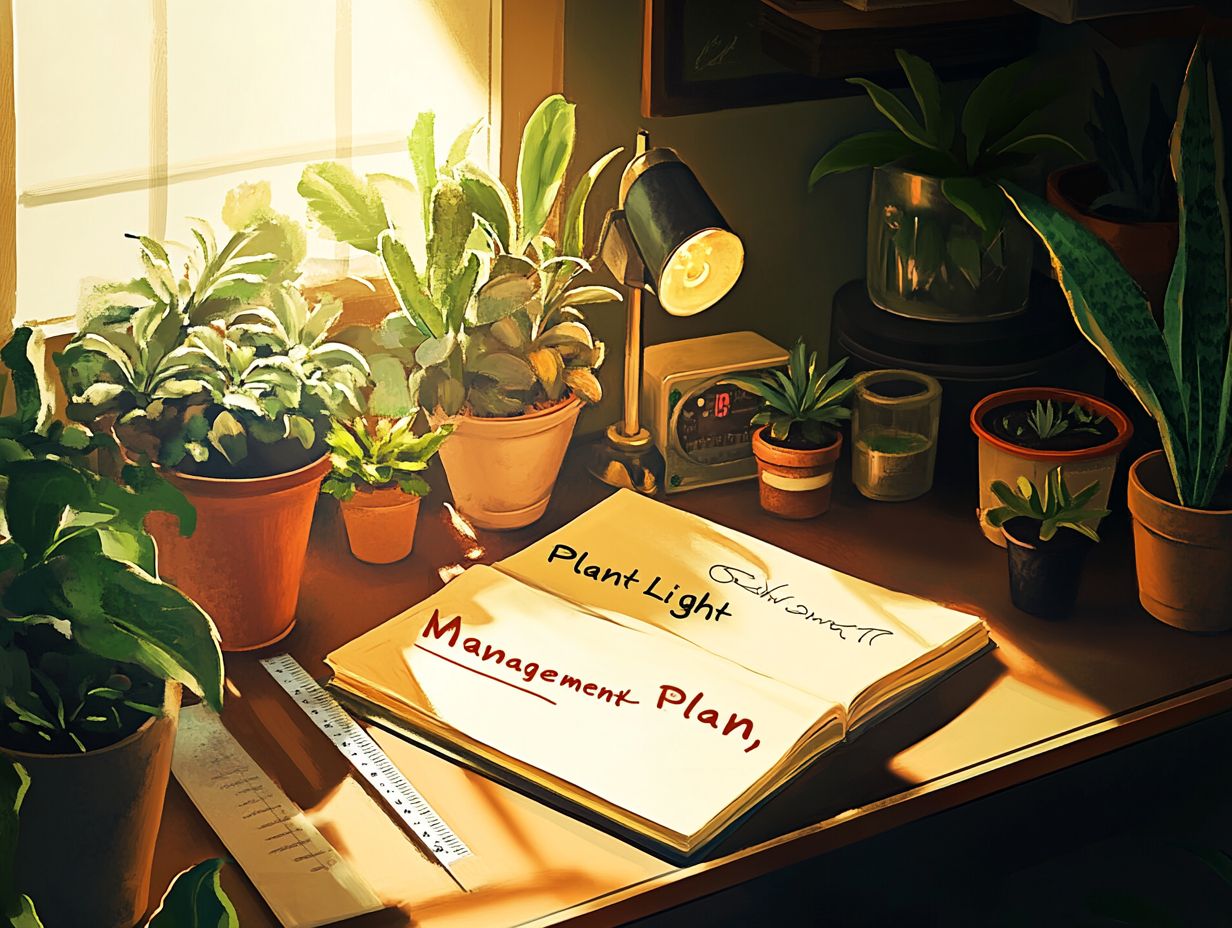
What is a plant light management plan?
A plant light management plan is a detailed strategy for effectively controlling and utilizing light sources for indoor or outdoor plants. It involves choosing the right type of light, determining appropriate placement and duration of light exposure, and monitoring and adjusting lighting conditions as needed.
Why is it important to create a plant light management plan?
A plant light management plan is important because it ensures your plants receive the optimal amount of light for healthy growth. Without a plan, plants may not receive enough light or may be exposed to too much light. This can lead to stunted growth, discoloration, and other negative effects.
What factors should be considered when creating a plant light management plan?
When creating a plant light management plan, consider factors such as the type of plants, their growth stage, natural light availability, and environmental conditions. These will help determine the type and intensity of light needed for your plants.
Can I use natural light for my plant light management plan?
Yes, natural light can be used as a light source in a plant light management plan. However, consider the amount and quality of natural light available, along with any potential fluctuations in light throughout the day.
How do I determine the right amount of light for my plants?
The right amount of light for plants can vary depending on the type of plant. Generally, most plants require 12-16 hours of light per day. It’s important to research the specific light requirements for your plants. You can also consult with a plant specialist for guidance.
What are some tips for monitoring and adjusting my plant light management plan?
Regularly monitor your plants for signs of over or underexposure to light. This is crucial for maintaining a successful plant light management plan. You should adjust the placement and duration of light exposure as plants grow and environmental conditions change.

